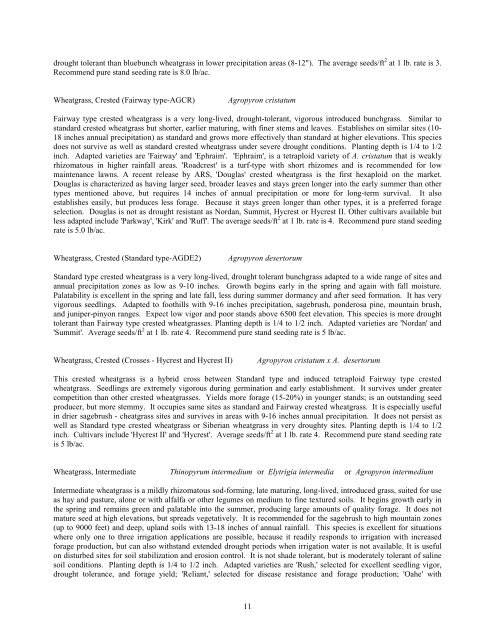Idaho Plant Materials Technical Note No. 24
Idaho Plant Materials Technical Note No. 24
Idaho Plant Materials Technical Note No. 24
You also want an ePaper? Increase the reach of your titles
YUMPU automatically turns print PDFs into web optimized ePapers that Google loves.
drought tolerant than bluebunch wheatgrass in lower precipitation areas (8-12"). The average seeds/ft 2 at 1 lb. rate is 3.<br />
Recommend pure stand seeding rate is 8.0 lb/ac.<br />
Wheatgrass, Crested (Fairway type-AGCR)<br />
Agropyron cristatum<br />
Fairway type crested wheatgrass is a very long-lived, drought-tolerant, vigorous introduced bunchgrass. Similar to<br />
standard crested wheatgrass but shorter, earlier maturing, with finer stems and leaves. Establishes on similar sites (10-<br />
18 inches annual precipitation) as standard and grows more effectively than standard at higher elevations. This species<br />
does not survive as well as standard crested wheatgrass under severe drought conditions. <strong>Plant</strong>ing depth is 1/4 to 1/2<br />
inch. Adapted varieties are 'Fairway' and 'Ephraim'. 'Ephraim', is a tetraploid variety of A. cristatum that is weakly<br />
rhizomatous in higher rainfall areas. 'Roadcrest' is a turf-type with short rhizomes and is recommended for low<br />
maintenance lawns. A recent release by ARS, 'Douglas' crested wheatgrass is the first hexaploid on the market.<br />
Douglas is characterized as having larger seed, broader leaves and stays green longer into the early summer than other<br />
types mentioned above, but requires 14 inches of annual precipitation or more for long-term survival. It also<br />
establishes easily, but produces less forage. Because it stays green longer than other types, it is a preferred forage<br />
selection. Douglas is not as drought resistant as <strong>No</strong>rdan, Summit, Hycrest or Hycrest II. Other cultivars available but<br />
less adapted include 'Parkway', 'Kirk' and 'Ruff'. The average seeds/ft 2 at 1 lb. rate is 4. Recommend pure stand seeding<br />
rate is 5.0 lb/ac.<br />
Wheatgrass, Crested (Standard type-AGDE2)<br />
Agropyron desertorum<br />
Standard type crested wheatgrass is a very long-lived, drought tolerant bunchgrass adapted to a wide range of sites and<br />
annual precipitation zones as low as 9-10 inches. Growth begins early in the spring and again with fall moisture.<br />
Palatability is excellent in the spring and late fall, less during summer dormancy and after seed formation. It has very<br />
vigorous seedlings. Adapted to foothills with 9-16 inches precipitation, sagebrush, ponderosa pine, mountain brush,<br />
and juniper-pinyon ranges. Expect low vigor and poor stands above 6500 feet elevation. This species is more drought<br />
tolerant than Fairway type crested wheatgrasses. <strong>Plant</strong>ing depth is 1/4 to 1/2 inch. Adapted varieties are '<strong>No</strong>rdan' and<br />
'Summit'. Average seeds/ft 2 at 1 lb. rate 4. Recommend pure stand seeding rate is 5 lb/ac.<br />
Wheatgrass, Crested (Crosses - Hycrest and Hycrest II)<br />
Agropyron cristatum x A. desertorum<br />
This crested wheatgrass is a hybrid cross between Standard type and induced tetraploid Fairway type crested<br />
wheatgrass. Seedlings are extremely vigorous during germination and early establishment. It survives under greater<br />
competition than other crested wheatgrasses. Yields more forage (15-20%) in younger stands; is an outstanding seed<br />
producer, but more stemmy. It occupies same sites as standard and Fairway crested wheatgrass. It is especially useful<br />
in drier sagebrush - cheatgrass sites and survives in areas with 9-16 inches annual precipitation. It does not persist as<br />
well as Standard type crested wheatgrass or Siberian wheatgrass in very droughty sites. <strong>Plant</strong>ing depth is 1/4 to 1/2<br />
inch. Cultivars include 'Hycrest II' and 'Hycrest'. Average seeds/ft 2 at 1 lb. rate 4. Recommend pure stand seeding rate<br />
is 5 lb/ac.<br />
Wheatgrass, Intermediate Thinopyrum intermedium or Elytrigia intermedia or Agropyron intermedium<br />
Intermediate wheatgrass is a mildly rhizomatous sod-forming, late maturing, long-lived, introduced grass, suited for use<br />
as hay and pasture, alone or with alfalfa or other legumes on medium to fine textured soils. It begins growth early in<br />
the spring and remains green and palatable into the summer, producing large amounts of quality forage. It does not<br />
mature seed at high elevations, but spreads vegetatively. It is recommended for the sagebrush to high mountain zones<br />
(up to 9000 feet) and deep, upland soils with 13-18 inches of annual rainfall. This species is excellent for situations<br />
where only one to three irrigation applications are possible, because it readily responds to irrigation with increased<br />
forage production, but can also withstand extended drought periods when irrigation water is not available. It is useful<br />
on disturbed sites for soil stabilization and erosion control. It is not shade tolerant, but is moderately tolerant of saline<br />
soil conditions. <strong>Plant</strong>ing depth is 1/4 to 1/2 inch. Adapted varieties are 'Rush,' selected for excellent seedling vigor,<br />
drought tolerance, and forage yield; 'Reliant,' selected for disease resistance and forage production; 'Oahe' with<br />
11
















